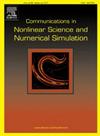Consistency-enhanced E-SAV BDF2 time-marching method with relaxation for the hydrodynamically-coupled binary phase-field crystal model
IF 3.4
2区 数学
Q1 MATHEMATICS, APPLIED
Communications in Nonlinear Science and Numerical Simulation
Pub Date : 2025-03-01
DOI:10.1016/j.cnsns.2025.108730
引用次数: 0
Abstract
This paper focuses on the hydrodynamically-coupled binary phase-field crystal (BPFC) model. Based on the -gradient flow, we derive the governing equations from the energy functional. To ensure the conservation of total mass, we incorporate two nonlocal Lagrange multipliers. For fluid dynamics, we employ the incompressible Navier–Stokes (NS) equations. Subsequently, we analytically prove the crucial property of energy dissipation within the model. To devise the numerical scheme, we reformulate the governing equations into an equivalent representation by incorporating an exponential scalar auxiliary variable (E-SAV). By leveraging the second-order backward difference formula (BDF2), we initially devise a second-order scheme and subsequently correct the energy through a relaxation technique applied to the E-SAV, with the objective of enhancing energy consistency. At every time step, due to the complete decoupling of variables, we solve only a limited number of elliptic equations to update the relevant variables. Furthermore, we analyze the unique solvability and energy stability of the time-discretized method. To confirm the performance of our proposed scheme, we perform various numerical experiments aimed at validating its effectiveness, accuracy, and stability.
求助全文
约1分钟内获得全文
求助全文
来源期刊

Communications in Nonlinear Science and Numerical Simulation
MATHEMATICS, APPLIED-MATHEMATICS, INTERDISCIPLINARY APPLICATIONS
CiteScore
6.80
自引率
7.70%
发文量
378
审稿时长
78 days
期刊介绍:
The journal publishes original research findings on experimental observation, mathematical modeling, theoretical analysis and numerical simulation, for more accurate description, better prediction or novel application, of nonlinear phenomena in science and engineering. It offers a venue for researchers to make rapid exchange of ideas and techniques in nonlinear science and complexity.
The submission of manuscripts with cross-disciplinary approaches in nonlinear science and complexity is particularly encouraged.
Topics of interest:
Nonlinear differential or delay equations, Lie group analysis and asymptotic methods, Discontinuous systems, Fractals, Fractional calculus and dynamics, Nonlinear effects in quantum mechanics, Nonlinear stochastic processes, Experimental nonlinear science, Time-series and signal analysis, Computational methods and simulations in nonlinear science and engineering, Control of dynamical systems, Synchronization, Lyapunov analysis, High-dimensional chaos and turbulence, Chaos in Hamiltonian systems, Integrable systems and solitons, Collective behavior in many-body systems, Biological physics and networks, Nonlinear mechanical systems, Complex systems and complexity.
No length limitation for contributions is set, but only concisely written manuscripts are published. Brief papers are published on the basis of Rapid Communications. Discussions of previously published papers are welcome.
 求助内容:
求助内容: 应助结果提醒方式:
应助结果提醒方式:


